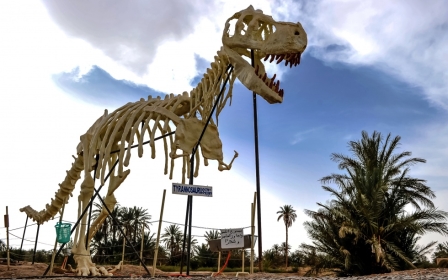Oldest human remains outside Africa found in cave in Israel

A partial jawbone bearing seven teeth found in a cave in Israel represents what scientists are calling the oldest-known Homo sapien remains outside Africa, showing that modern humans trekked out of that continent far earlier than previously known.
Researchers on Thursday announced the discovery of the fossil estimated as 177,000 to 194,000 years old, and said the teeth bore tell-tale traits of Homo sapiens not present in close human relatives alive at the time, including Neanderthals.
The fossil of the left part of the upper jaw of a young adult - the person's sex remains unclear - came from Misliya Cave on Mount Carmel's western slopes in northern Israel. Also found inside the large collapsed cave, once inhabited by humans, were blades and other stone tools that were sophisticated for the time, several hearths and burned animal bones.
“Misliya is an exciting discovery,” said Rolf Quam, an anthropology professor at Binghamton University in the US and a co-author of the study.
“It provides the clearest evidence yet that our ancestors first migrated out of Africa much earlier than we previously believed. It also means that modern humans were potentially meeting and interacting during a longer period of time with other archaic human groups, providing more opportunity for cultural and biological exchanges.”
Misliya Cave is part of a series of caves known as Nahal Mearot in Hebrew and Wadi el-Mughara in Arabic which are recognised on UNESCO's world heritage list as a site of human evolution.
The jawbone was found in 2002 by students during an archaeological dig and has been independently dated by three teams, according to a study about the discovery published in the Science journal.
Homo sapiens first appeared in Africa, with the earliest-known fossils roughly 300,000 years old. A key milestone was when our species first ventured out of Africa en route to populating the far corners of the globe.
Until now, the oldest Homo sapien fossils outside Africa had come from two other cave sites in Israel, including one also on Mount Carmel, and were about 90,000 to 120,000 years old.
The new discovery supports the idea that humans migrated out of Africa through a northern route, the Nile valley and the eastern Mediterranean coast - and not a southern route across the Bab al-Mandeb strait, the southern coast of Saudi Arabia, the Indian subcontinent and East Asia, said Tel Aviv University paleoanthropologist Israel Hershkovitz, who led the study.
Hershkovitz said he believes Homo sapiens may have originated some 500,000 years ago.
The Misliya humans were likely nomadic, moving around the landscape following the movements of prey species or according to the seasons of the year, Quam said.
"They were capable hunters of large-game species including wild cattle, deer and gazelles. They also made extensive use of plant materials, including perhaps for bedding," Quam added.
New MEE newsletter: Jerusalem Dispatch
Sign up to get the latest insights and analysis on Israel-Palestine, alongside Turkey Unpacked and other MEE newsletters
Middle East Eye delivers independent and unrivalled coverage and analysis of the Middle East, North Africa and beyond. To learn more about republishing this content and the associated fees, please fill out this form. More about MEE can be found here.




